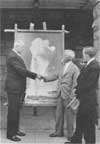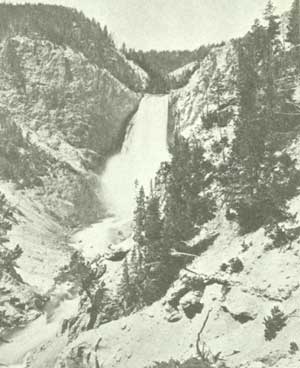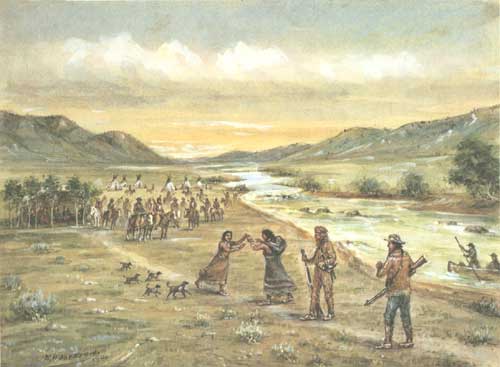
INTRODUCTION
By Marian Albright Schenk
FOREWORD
By Dean Knudsen
SECTION 1
Primary Themes of Jackson's Art
SECTION 2
Paintings of the Oregon Trail
SECTION 3
Historic Scenes From the West
 |
| In 1934 Yellowstone National Park sponsored a special exhibit of the work of William Henry Jackson. In this photograph the men are identified as Farley, Jackson, and Wyoming Governor O'Mahoney. (SCBL 2708) |

Section 3: Historic Scenes from the West
LEWIS AND CLARK
The importance of the Lewis and Clark Expedition to the opening of the Far West cannot be overstated. Although the expedition failed to find an easy trade route to the Northwest, this epic two-year journey up the Missouri River, across the Rocky Mountains, and down the Columbia River to the Pacific Ocean proved that it was possible to travel safely through the vastness of the Far West.
An added bonus that paid dividends for later explorers came in the form of the meticulous maps and observations that Meriwether Lewis and William Clark made of the people, land features, animals and plants that they saw along the way. The final success of the expedition, if not their very survival, may have been due to the presence of a Shoshone woman named Sacagawea.
 |
| This photograph of the Lower Falls of the Yellowstone was taken by Jackson in 1871. Images such as this were very popular, and were sold as prints and stereo cards, which when seen through a special viewer appeared to be three-dimensional. (SCBL 989) |
Few individuals in American history have been the subject of as much romantic speculation as Sacagawea. The facts that are known about this woman are sparse. What is known is that Sacagawea had been kidnapped as a young girl and raised by the Minitaris. Later she was purchased and made a wife of Toussaint Charbonneau, a fur trading French-Canadian employed by the Northwest Company
Charbonneau was hired as an interpreter and guide in November 1804 while Lewis and Clark were spending the winter at the Mandan villages on the upper Missouri River. Although Sacagawea was pregnant at the time, Lewis and Clark allowed her to accompany the expedition when their westward journey was resumed in the spring of 1805. Lewis and Clark knew that having a Shoshone along might help them to establish good relations when they came into contact with that powerful tribe.1
Jackson's painting, "Historic Homecoming" depicts Lewis and Clark returning Sacagawea to her Shoshone tribe on Horse Prairie Creek, in western Montana. This event took place on the morning of August 15, 1805, near a site that came to be known as Camp Fortunate. No better name could have been chosen, for during a council with a Shoshone chieftain named Cameahwait, Sacagawea recognized him as her brother.2 Needless to say, Sacagawea's presence on this particular occasion justified the decision to bring her on the expedition.
1. Roy E. Appleman, Lewis and Clark (Washington, D.C.: National Park Service, 1975), 114-115.
2. Ibid., 160-161.
 |
| Historic Homecoming. Signed and dated 1940. 28.0 x 38.1 cm. (SCBL 152) |
 |
scbl/knudsen/sec3b.htm Last Updated: 14-Apr-2006 |
 |